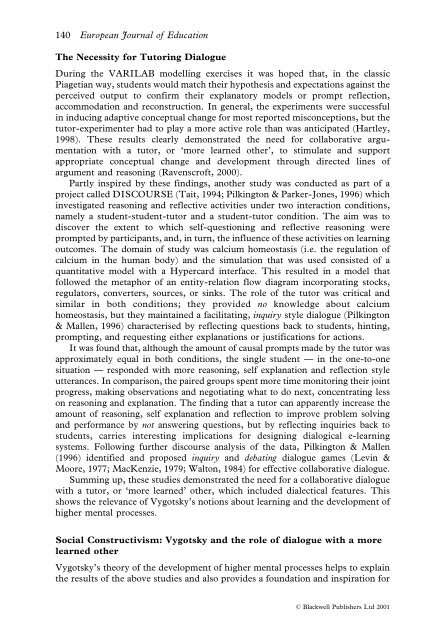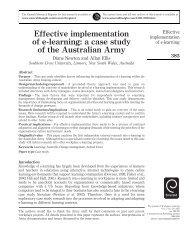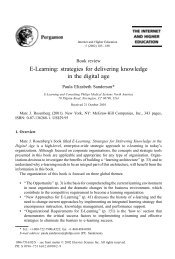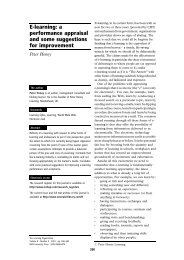Designing E-learning Interactions in the 21st Century: revisiting and ...
Designing E-learning Interactions in the 21st Century: revisiting and ...
Designing E-learning Interactions in the 21st Century: revisiting and ...
You also want an ePaper? Increase the reach of your titles
YUMPU automatically turns print PDFs into web optimized ePapers that Google loves.
140 European Journal of Education<br />
The Necessity for Tutor<strong>in</strong>g Dialogue<br />
Dur<strong>in</strong>g <strong>the</strong> VARILAB modell<strong>in</strong>g exercises it was hoped that, <strong>in</strong> <strong>the</strong> classic<br />
Piagetian way, students would match <strong>the</strong>ir hypo<strong>the</strong>sis <strong>and</strong> expectations aga<strong>in</strong>st <strong>the</strong><br />
perceived output to confirm <strong>the</strong>ir explanatory models or prompt reflection,<br />
accommodation <strong>and</strong> reconstruction. In general, <strong>the</strong> experiments were successful<br />
<strong>in</strong> <strong>in</strong>duc<strong>in</strong>g adaptive conceptual change for most reported misconceptions, but <strong>the</strong><br />
tutor-experimenter had to play a more active role than was anticipated (Hartley,<br />
1998). These results clearly demonstrated <strong>the</strong> need for collaborative argumentation<br />
with a tutor, or `more learned o<strong>the</strong>r', to stimulate <strong>and</strong> support<br />
appropriate conceptual change <strong>and</strong> development through directed l<strong>in</strong>es of<br />
argument <strong>and</strong> reason<strong>in</strong>g (Ravenscroft, 2000).<br />
Partly <strong>in</strong>spired by <strong>the</strong>se f<strong>in</strong>d<strong>in</strong>gs, ano<strong>the</strong>r study was conducted as part of a<br />
project called DISCOURSE (Tait, 1994; Pilk<strong>in</strong>gton & Parker-Jones, 1996) which<br />
<strong>in</strong>vestigated reason<strong>in</strong>g <strong>and</strong> reflective activities under two <strong>in</strong>teraction conditions,<br />
namely a student-student-tutor <strong>and</strong> a student-tutor condition. The aim was to<br />
discover <strong>the</strong> extent to which self-question<strong>in</strong>g <strong>and</strong> reflective reason<strong>in</strong>g were<br />
prompted by participants, <strong>and</strong>, <strong>in</strong> turn, <strong>the</strong> <strong>in</strong>fluence of <strong>the</strong>se activities on <strong>learn<strong>in</strong>g</strong><br />
outcomes. The doma<strong>in</strong> of study was calcium homeostasis (i.e. <strong>the</strong> regulation of<br />
calcium <strong>in</strong> <strong>the</strong> human body) <strong>and</strong> <strong>the</strong> simulation that was used consisted of a<br />
quantitative model with a Hypercard <strong>in</strong>terface. This resulted <strong>in</strong> a model that<br />
followed <strong>the</strong> metaphor of an entity-relation flow diagram <strong>in</strong>corporat<strong>in</strong>g stocks,<br />
regulators, converters, sources, or s<strong>in</strong>ks. The role of <strong>the</strong> tutor was critical <strong>and</strong><br />
similar <strong>in</strong> both conditions; <strong>the</strong>y provided no knowledge about calcium<br />
homeostasis, but <strong>the</strong>y ma<strong>in</strong>ta<strong>in</strong>ed a facilitat<strong>in</strong>g, <strong>in</strong>quiry style dialogue (Pilk<strong>in</strong>gton<br />
& Mallen, 1996) characterised by reflect<strong>in</strong>g questions back to students, h<strong>in</strong>t<strong>in</strong>g,<br />
prompt<strong>in</strong>g, <strong>and</strong> request<strong>in</strong>g ei<strong>the</strong>r explanations or justifications for actions.<br />
It was found that, although <strong>the</strong> amount of causal prompts made by <strong>the</strong> tutor was<br />
approximately equal <strong>in</strong> both conditions, <strong>the</strong> s<strong>in</strong>gle student Ð <strong>in</strong> <strong>the</strong> one-to-one<br />
situation Ð responded with more reason<strong>in</strong>g, self explanation <strong>and</strong> reflection style<br />
utterances. In comparison, <strong>the</strong> paired groups spent more time monitor<strong>in</strong>g <strong>the</strong>ir jo<strong>in</strong>t<br />
progress, mak<strong>in</strong>g observations <strong>and</strong> negotiat<strong>in</strong>g what to do next, concentrat<strong>in</strong>g less<br />
on reason<strong>in</strong>g <strong>and</strong> explanation. The f<strong>in</strong>d<strong>in</strong>g that a tutor can apparently <strong>in</strong>crease <strong>the</strong><br />
amount of reason<strong>in</strong>g, self explanation <strong>and</strong> reflection to improve problem solv<strong>in</strong>g<br />
<strong>and</strong> performance by not answer<strong>in</strong>g questions, but by reflect<strong>in</strong>g <strong>in</strong>quiries back to<br />
students, carries <strong>in</strong>terest<strong>in</strong>g implications for design<strong>in</strong>g dialogical e-<strong>learn<strong>in</strong>g</strong><br />
systems. Follow<strong>in</strong>g fur<strong>the</strong>r discourse analysis of <strong>the</strong> data, Pilk<strong>in</strong>gton & Mallen<br />
(1996) identified <strong>and</strong> proposed <strong>in</strong>quiry <strong>and</strong> debat<strong>in</strong>g dialogue games (Lev<strong>in</strong> &<br />
Moore, 1977; MacKenzie, 1979; Walton, 1984) for effective collaborative dialogue.<br />
Summ<strong>in</strong>g up, <strong>the</strong>se studies demonstrated <strong>the</strong> need for a collaborative dialogue<br />
with a tutor, or `more learned' o<strong>the</strong>r, which <strong>in</strong>cluded dialectical features. This<br />
shows <strong>the</strong> relevance of Vygotsky's notions about <strong>learn<strong>in</strong>g</strong> <strong>and</strong> <strong>the</strong> development of<br />
higher mental processes.<br />
Social Constructivism: Vygotsky <strong>and</strong> <strong>the</strong> role of dialogue with a more<br />
learned o<strong>the</strong>r<br />
Vygotsky's <strong>the</strong>ory of <strong>the</strong> development of higher mental processes helps to expla<strong>in</strong><br />
<strong>the</strong> results of <strong>the</strong> above studies <strong>and</strong> also provides a foundation <strong>and</strong> <strong>in</strong>spiration for<br />
ß Blackwell Publishers Ltd 2001
















